August 1, 2015
by Mikhail Elyashberg, Leading Researcher, ACD/Labs
Arboridinine
Plants of the genus Kopsia (Apocynaceae) are distributed mainly over Southeast Asia, India, China, and Australia. Plants belonging to this genus are rich in indole alkaloids, and the Malaysian representatives in particular have proven to be prodigious sources of novel alkaloids with unusual or intriguing carbon skeletons and interesting biological activity. Some examples of such alkaloids are characterized by complex polycyclic skeletons—for instance, the curious tetracyclic alkaloid, mersicarpine, constituted from the fusion of a dihydroindole (a seven-membered cyclic imine) and a δ-lactam moiety.
S.P. Wong et al [1] investigated the alkaloid content of K. arborea Blume, and report the isolation and structure determination of a new pentacyclic monoterpenoid indole alkaloid, Arboridinine (1), characterized by an unprecedented molecular skeleton.
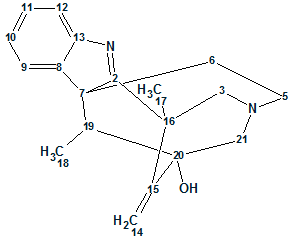
1
Arboridinine was initially obtained as a colorless oil, and subsequently crystallized from CH2Cl2/hexanes as colorless needles. The IR spectrum showed an OH absorption band at 3280 cm-1, while the UV spectrum showed characteristic indolenine absorption maxima at 222 and 251 nm. The ESIMS showed an [M + H]+ peak at m/z 295, and HRESIMS measurements established the molecular formula as C19H22N2O.
The structure of Arboridinine was determined using 1D and 2D NMR spectra (HSQC, HMBC, COSY and NOESY) and confirmed by X-ray diffraction analysis. Only key HMBC correlations were presented in the article. The NMR spectroscopic data which were input into the ACD/Structure Elucidator Suite software are collected in Table 1.
Table 1. NMR spectroscopic data for Arboridinine.
| Label | δC | δC Calc | XHn | δH | M | COSY | C HMBC |
| C 2 | 189.1 | 198.15 | C | ||||
| C 3 | 62.3 | 65.1 | CH2 | 3.11 | u | ||
| C 3 | 62.3 | 65.1 | CH2 | 3.09 | u | C 5 | |
| C 5 | 53 | 48.89 | CH2 | 3.46 | u | ||
| C 5 | 53 | 48.89 | CH2 | 3.2 | u | 1.57 | C 21, C 3 |
| C 6 | 34.1 | 28.24 | CH2 | 1.57 | u | 3.2 | C 2 |
| C 6 | 34.1 | 28.24 | CH2 | 2.32 | u | ||
| C 7 | 61.5 | 54.89 | C | ||||
| C 8 | 145.4 | 144.38 | C | ||||
| C 9 | 122 | 122.02 | CH | 7.15 | u | 7.18 | C 7, C 13, C 11 |
| C 10 | 125.6 | 124.32 | CH | 7.18 | u | 7.26, 7.15 | C 8 |
| C 11 | 127.6 | 127.87 | CH | 7.26 | u | 7.18, 7.55 | C 9 |
| C 12 | 120.9 | 120.6 | CH | 7.55 | u | 7.26 | |
| C 13 | 152.8 | 153.98 | C | ||||
| C 14 | 105 | 105.94 | CH2 | 5.06 | u | ||
| C 14 | 105 | 105.94 | CH2 | 5.05 | u | C 20, C 16 | |
| C 15 | 153.3 | 150.45 | C | ||||
| C 16 | 49.3 | 50.52 | C | ||||
| C 17 | 18.1 | 26.09 | CH3 | 1.51 | u | C 15, C 3, C 2 | |
| C 18 | 12.6 | 12.2 | CH3 | 0.39 | u | 2.59 | C 7, C 20 |
| C 19 | 48.3 | 44.31 | CH | 2.59 | u | 0.39 | |
| C 20 | 73.7 | 75.04 | C | ||||
| C 21 | 66.2 | 59.54 | CH2 | 3.36 | u | ||
| C 21 | 66.2 | 59.54 | CH2 | 3.26 | u | C 5 |
A Molecular Connectivity Diagram (MCD) was created from these data and is shown in Figure 1.
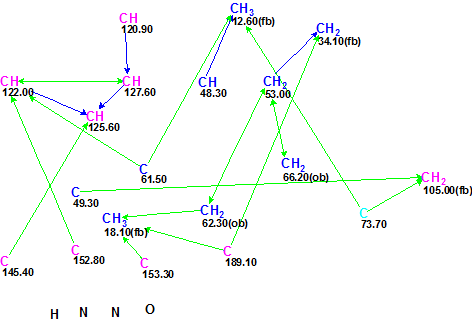
Figure 1. Molecular Connectivity Diagram for Arboridinine.
No edits were made to the initial MCD. The software did not detect any contradictions in the 2D NMR data, and so Strict Structure Generation accompanied with increment-based 13C chemical shift calculation was initiated. Structures with average deviations (d) greater than 5 ppm were rejected during structure generation. The results were: k = 705 → 3,tg = 1s. The output structural file for these three candidates, ranked in order of increasing 13C chemical shift average deviations, is shown in Figure 2.
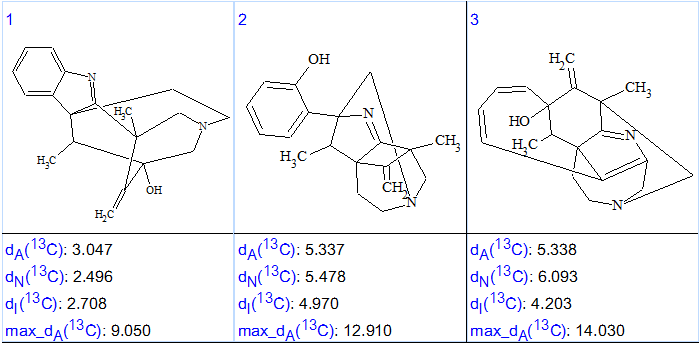
Figure 2. Ranked structural output file for Arboridinine.
By comparing structure 1 with the top ranked structural candidate #1 (Figure 2) leads to the conclusion that the unprecedented structure of Arboridinine was reliably determined by Structure Elucidator Suite instantly. A difference of ~2ppm between the deviations calculated for structures #1 and #2 also indicates that #1 is the structure which best matches the experimental data.
The 13C chemical shift assignments coinciding with those suggested by authors [1] are shown in structure 2.
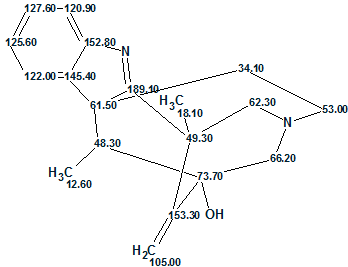
2
It is interesting to note that the 13C chemical shift value of 189.10 ppm is uncommonly high for a carbon included in a C=N bond. A chemical shift at ~190 ppm is more characteristic for a ketone group. This possibility can easily be verified using Structure Elucidator Suite. When a C=O bond was drawn by hand on MCD (Figure 1), structure generation (without 13C chemical shift prediction) gave the following result: k = 39 → 6, tg = 0.02s. The three top ranked structures are shown in Figure 3.
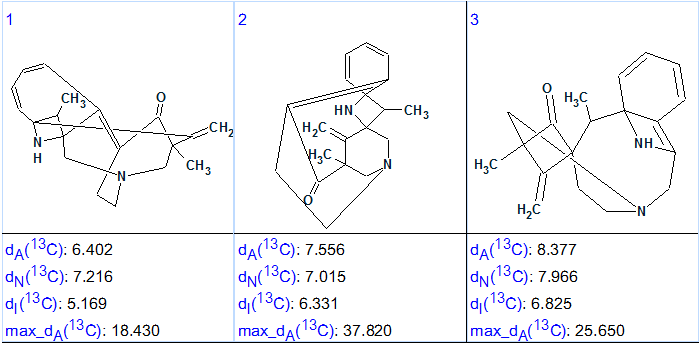
Figure 3. Ranked structural output file obtained for Arboridinine, as a result of generation of structures including a carbonyl group.
We see that both the chemical deviation values and peculiarities of structures convincingly prove that the carbonyl group can not be included into the target structure. Therefore the structure of Arboridinine, which represents a new and previously unknown skeleton of the monoterpenoid indoles, was unambiguously and instantly identified by Structure Elucidator Suite.
References
- S.-P. Wong, C.-Y. Gan, K.-H.Lim, K.-N. Ting, Y.-Y/ Low, T.-S. Kam. (2015). Arboridinine, a Pentacyclic Indole Alkaloid with a New Cage Carbon-Nitrogen Skeleton Derived from a Pericine Precursor. Org. Lett. 17(14):3628-3631.


